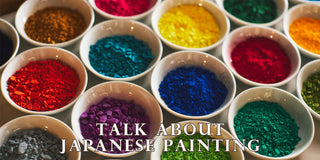Talk about Japanese painting
Specializing in pigment for Japanese painting over 270 years in business.This time, We talk about Japanese paintings.
Do you know Nihonga?
Do you know Nihonga (Japanese-style paintings)?
It is a general term for traditional Japanese painting.
In art textbooks and museums, you may see the names and works of Japanese painting masters.
But the Japanese do not learn the technique of Japanese painting when they are children. What could be the reason...?

What is Japanese Painting?

The distinction between Western-style oil painting and Nihonga is, broadly speaking, the difference in the painting materials used.
In general, the support is paper, silk, wood, or plaster, to which Sumi ink, mineral pigments, white Gofun (a white pigment made from pulverized seashells), animal or vegetable coloring materials, and other natural pigments were applied with Nikawa(an animal glue).
To prevent it from cracking and peeling, gofun should be mixed with glue with time and care. Because it is used frequently for various purposes but takes time to prepare, it is best to prepare a generous amount of this glue mixture and then to scoop the amount required each time onto a palette for use.


Those materials are not easy to use. Mastering the necessary techniques requires considerable time and determination.
The colors are painted over and over again because they can only put on materials a little bit at a time.
Japanese paintings' colors are produced by overlaying one color over another.
Especially with Iwaenogu, the primary coat tends to show through easily.
Therefore, it is best to apply it in several coats, and allow it to dry between each coat, to fill in the gaps between the particles.
A rich tone can be achieved by layering different colors for each coat.


Just one color should be used on a single palette dish. This is because in Japanese paintings colors are produced by overlaying one color over another. Complex tints can be produced by overlaying the paint in several coats, allowing each coat to dry before applying the next coat.
Gofun is mainly used as the undercoat before applying iwa-enogu. It has the effect of smoothing out the grains on washi paper and helping the iwa-enogu applied over the top to fix.
With iwa-enogu, the primary coat tends to show through easily. Therefore, it is best to apply it in several coats, and allow to dry between each coat, to fill in the gaps between the particles.


We are holding a Japanese painting pigment instructional workshop.
The abundant number of colors and beautiful colors of Japanese paints make it possible to create wonderful works in various fields.
Please enjoy Japanese pigment colors and Japanese painting!
